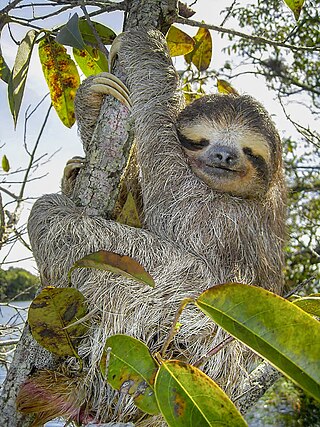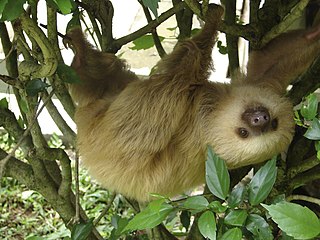
Anoa, also known as dwarf buffalo and sapiutan, are two species of the genus Bubalus, placed within the subgenus Anoa and endemic to the island of Sulawesi in Indonesia: the mountain anoa and the lowland anoa. Both live in undisturbed rainforests and are similar in appearance to miniature water buffaloes, weighing 150–300 kg (330–660 lb).

Ground sloths are a diverse group of extinct sloths in the mammalian superorder Xenarthra. They varied widely in size with the largest, belonging to genera Lestodon, Eremotherium and Megatherium, being around the size of elephants. Ground sloths represent a paraphyletic group, as living tree sloths are thought to have evolved from ground sloth ancestors.

Histeridae is a family of beetles commonly known as clown beetles or hister beetles. This very diverse group of beetles contains 3,900 species found worldwide. They can be easily identified by their shortened elytra that leaves two of the seven tergites exposed, and their geniculate (elbowed) antennae with clubbed ends. These predatory feeders are most active at night and will fake death if they feel threatened. This family of beetles will occupy almost any kind of niche throughout the world. Hister beetles have proved useful during forensic investigations to help in time of death estimation. Also, certain species are used in the control of livestock pests that infest dung and to control houseflies. Because they are predacious and will even eat other hister beetles, they must be isolated when collected.

The pale-throated sloth, occasionally known as the ai, is a species of three-toed sloth that inhabits tropical rainforests in northern South America.

The maned sloth is a three-toed sloth that is native to South America. It is one of four species of three-toed sloths belonging to the suborder Xenarthra and are placental mammals. They are endemic to the Atlantic coastal rainforest of southeastern and northeastern Brazil, located in the states of Espírito Santo, Rio de Janeiro and Bahia. Each of the individuals within the species are genetically distinct with different genetic makeup.The maned sloth is listed under Vulnerable (VU) according to the IUCN Red List and have a decreasing population trend.

The brown-throated sloth is a species of three-toed sloth found in the Neotropical realm of Central and South America.

The Hoffmann's two-toed sloth, also known as the northern two-toed sloth, is a species of sloth from Central and South America. It is a solitary, largely nocturnal and arboreal animal, found in mature and secondary rainforests and deciduous forests. The common name commemorates the German naturalist Karl Hoffmann, who discovered the Hoffmann sloth.

Linnaeus's two-toed sloth, also known as the southern two-toed sloth, unau, or Linne's two-toed sloth is a species of sloth from South America, found in Venezuela, Suriname, Guyana, French Guiana, Colombia, Ecuador, Peru, and Brazil north of the Amazon River. There is now evidence suggesting the species' range expands into Bolivia. It's the largest extant sloth species.

The scarab beetle subfamily Scarabaeinae consists of species collectively called true dung beetles. Most of the beetles of this subfamily feed exclusively on dung. However, some may feed on decomposing matter including carrion, decaying fruits and fungi. Dung beetles can be placed into three structural guilds based on their method of dung processing namely rollers (telecoprids), dwellers (endocoprids) and tunnelers (paracoprids). Dung removal and burial by dung beetles result in ecological benefits such as soil aeration and fertilization; improved nutrient cycling and uptake by plants, increase in Pasture quality, biological control of pest flies and intestinal parasites and secondary seed dispersal. Well-known members include the genera Scarabaeus and Sisyphus, and Phanaeus vindex.

Choloepus is a genus of xenarthran mammals from Central and South America within the monotypic family Choloepodidae, consisting of two-toed sloths, sometimes also called two-fingered sloths. The two species of Choloepus, Linnaeus's two-toed sloth and Hoffmann's two-toed sloth, were formerly believed on the basis of morphological studies to be the only surviving members of the sloth family Megalonychidae, but have now been shown by molecular results to be closest to extinct ground sloths of the family Mylodontidae.

The three-toed or three-fingered sloths are arboreal neotropical mammals. They are the only members of the genus Bradypus and the family Bradypodidae. The five living species of three-toed sloths are the brown-throated sloth, the maned sloth, the pale-throated sloth, the southern maned sloth, and the pygmy three-toed sloth. In complete contrast to past morphological studies, which tended to place Bradypus as the sister group to all other folivorans, molecular studies place them nested within the sloth superfamily Megatherioidea, making them the only surviving members of that radiation.

Sloths are a Neotropical group of xenarthran mammals constituting the suborder Folivora, including the extant arboreal tree sloths and extinct terrestrial ground sloths. Noted for their slowness of movement, tree sloths spend most of their lives hanging upside down in the trees of the tropical rainforests of South America and Central America. Sloths are considered to be most closely related to anteaters, together making up the xenarthran order Pilosa.

The pygmy three-toed sloth, also known as the monk sloth or dwarf sloth, is a species of sloth in the family Bradypodidae. The species is endemic to Isla Escudo de Veraguas, a small island off the Caribbean coast of Panama. The species was first described by Robert P. Anderson of the University of Kansas and Charles O. Handley Jr., of the Smithsonian Institution in 2001. The pygmy three-toed sloth is significantly smaller than the other three members of its genus, but otherwise resembles the brown-throated three-toed sloth. According to Anderson and Handley Jr., the head-and-body length is between 48 and 53 centimetres, and the body mass ranges from 2.5 to 3.5 kg.
Semelparity and iteroparity are two contrasting reproductive strategies available to living organisms. A species is considered semelparous if it is characterized by a single reproductive episode before death, and iteroparous if it is characterized by multiple reproductive cycles over the course of its lifetime. Iteroparity can be further divided into continuous iteroparity and seasonal iteroparity Some botanists use the parallel terms monocarpy and polycarpy.

Insects are hexapod invertebrates of the class Insecta. They are the largest group within the arthropod phylum. Insects have a chitinous exoskeleton, a three-part body, three pairs of jointed legs, compound eyes, and a pair of antennae. Insects are the most diverse group of animals, with more than a million described species; they represent more than half of all animal species.
Bradypodicola hahneli is a sloth moth in the family Pyralidae that lives exclusively in the fur of the pale-throated three-toed sloth, a three-toed sloth found in South America. It is the only species of the genus Bradypodicola.

A sloth moth is a coprophagous moth which has evolved to exclusively inhabit the fur of sloths and to use sloth dung as a substrate for the early stages of reproduction. Sloth moths include Bradypodicola hahneli, Cryptoses choloepi, Cryptoses waagei, Cryptoses rufipictus, and Bradypophila garbei.

A large number of arthropods are associated with sloths. These include biting and blood-sucking flies such as mosquitoes and sandflies, triatomine bugs, lice, ticks and mites. The sloth’s fur forms a micro-ecozone inhabited by green algae and hundreds of insects. Sloths have a highly specific community of commensal beetles, mites and moths.

Phoresis or phoresy is a temporary commensalistic relationship when an organism attaches itself to a host organism solely for travel. It has been seen in ticks and mites since the 18th century, and in fossils 320 million years old. It is not restricted to arthropods or animals; plants with seeds that disperse by attaching themselves to animals are also considered to be phoretic.

Nothrotheriidae is a family of extinct ground sloths that lived from approximately 17.5 mya—10,000 years ago, existing for approximately 17.49 million years. Previously placed within the tribe Nothrotheriini or subfamily Nothrotheriinae within Megatheriidae, they are now usually placed in their own family, Nothrotheriidae. Nothrotheriids appeared in the Burdigalian, some 19.8 million years ago, in South America. The group includes the comparatively slightly built Nothrotheriops, which reached a length of about 2.75 metres (9.0 ft). While nothrotheriids were small compared to some of their megatheriid relatives, their claws provided an effective defense against predators, like those of larger anteaters today.















